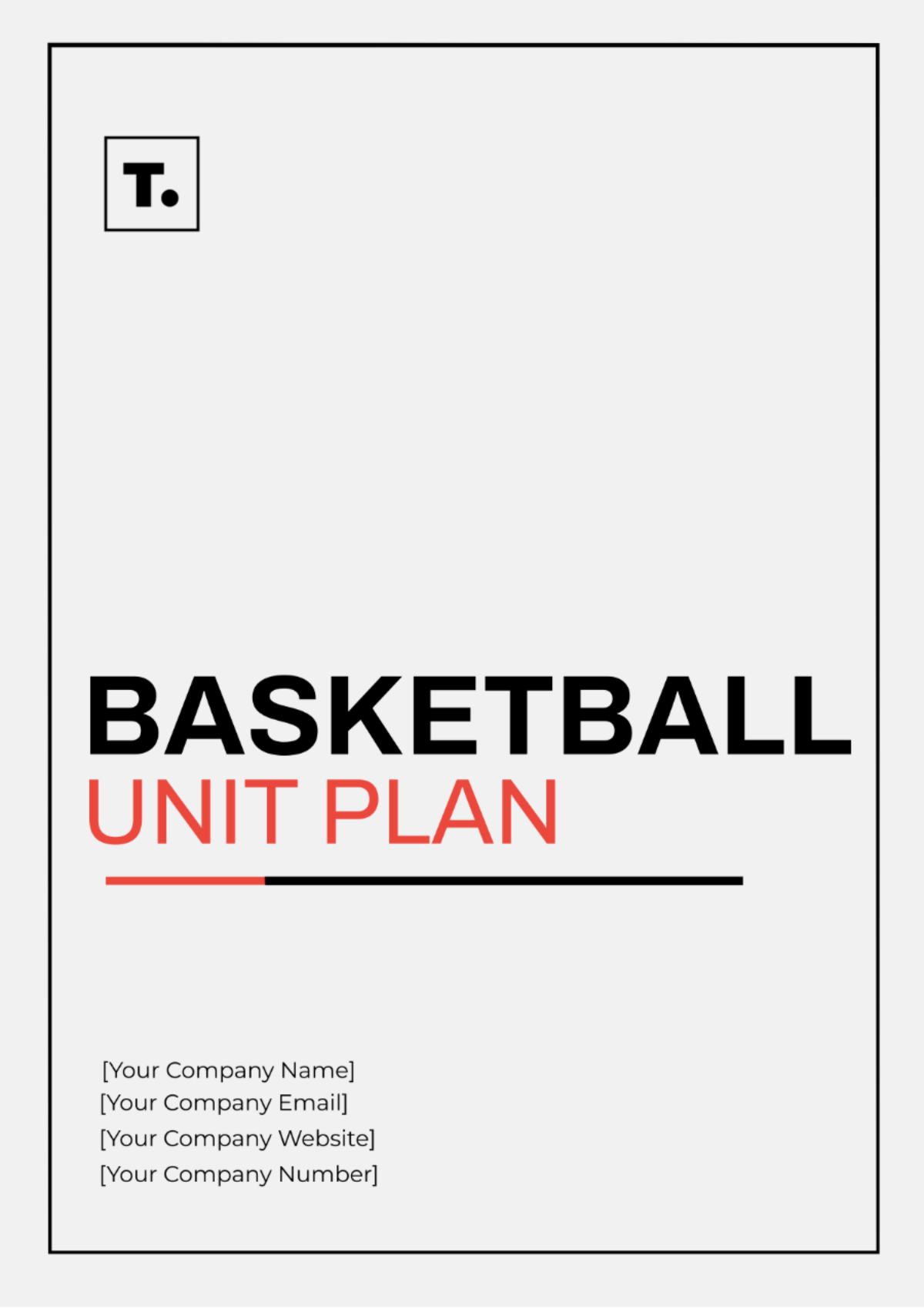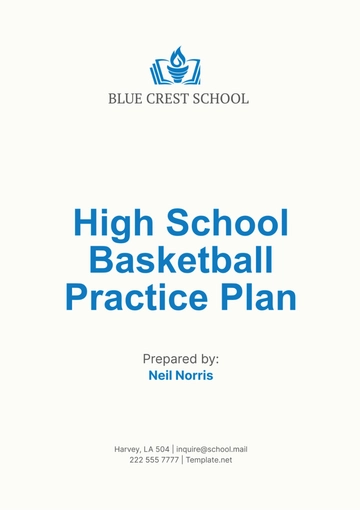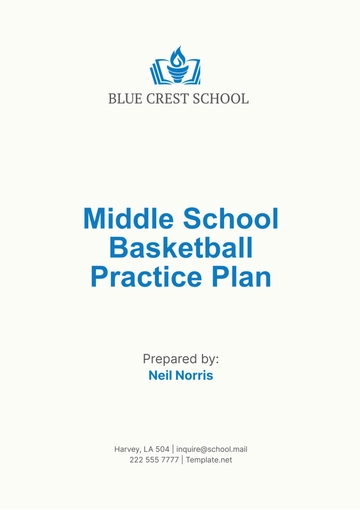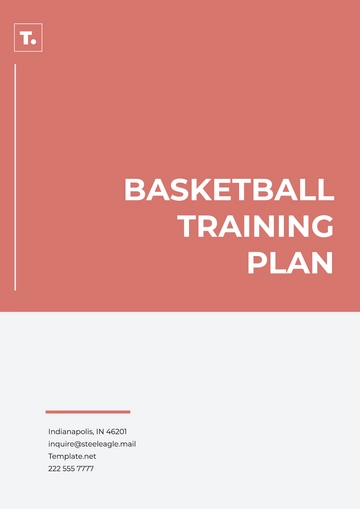Free Basketball Unit Plan

I. Introduction
This Basketball Unit Plan is designed for middle school students and aims to introduce fundamental basketball skills while promoting physical activity and teamwork. The unit spans four weeks and includes progressive lessons to develop skills gradually.
II. Curriculum Standards
A. Coordination
Activities and drills are designed to improve hand-eye coordination, footwork, and overall body control.
Students will engage in various exercises such as dribbling drills, passing accuracy challenges, and agility ladder exercises to enhance coordination.
B. Agility
Agility-focused drills aim to improve students' ability to change direction quickly, accelerate, and decelerate efficiently on the basketball court.
Exercises may include shuttle runs, lateral movement drills, and defensive agility drills to develop agility specific to basketball movements.
C. Teamwork
Emphasis is placed on collaborative activities that require students to work together towards a common goal.
Small-sided games, passing drills, and team-based challenges encourage students to communicate, cooperate, and support each other on the court.
D. Sportsmanship
Lessons incorporate discussions and demonstrations of good sportsmanship values such as respect, fair play, and integrity.
Students are encouraged to exhibit positive behaviors towards teammates, opponents, coaches, and officials, promoting a culture of respect and camaraderie.
III. Unit Overview
A. Duration
The unit is designed to extend over a period of four weeks, thereby offering students a substantial amount of time to progressively learn and practice the fundamental skills associated with basketball.
B. Focus Areas
Dribbling: Students will learn and practice various dribbling techniques, including basic dribbles, crossover dribbles, and behind-the-back dribbles. Emphasis will be placed on dribbling with control and speed.
Passing: Students will develop passing skills such as chest passes, bounce passes, and overhead passes. They will also learn the importance of accurate passing and timing in game situations.
Shooting: Students will focus on shooting form, including proper stance, hand placement, and follow-through. Shooting drills will cover layups, jump shots, and free throws, aiming to improve shooting accuracy and consistency.
Defense: Students will learn defensive principles such as stance, footwork, and positioning. Defensive drills will focus on skills such as guarding the ball handler, contesting shots, and intercepting passes.
C. Themes
Skill Development: Throughout the unit, students will work on developing and refining their basketball skills through structured drills, exercises, and game simulations. Progression will be tailored to accommodate different skill levels and learning styles.
Game Understanding: Students will deepen their understanding of basketball concepts and strategies, including offensive and defensive tactics, player roles, and game situations. This will be achieved through classroom discussions, video analysis, and on-court simulations.
Fitness: The unit will promote physical fitness by incorporating cardiovascular exercises, strength training, and endurance drills. Students will engage in basketball-specific conditioning activities to improve agility, speed, and overall athleticism.
IV. Schedule
Week | Lessons |
|---|---|
Week 1 | - Introduction to basketball rules and terminology - Basic ball handling and dribbling drills - Passing and receiving techniques |
Week 2 | - Shooting form and layup drills - Defensive stance and footwork - Review of dribbling and passing skills |
Week 3 | - Small-sided games focusing on passing and teamwork - Shooting practice under pressure - Defensive drills and strategies |
Week 4 | - Full-court scrimmages emphasizing all skills learned - Assessment of individual skill proficiency - Reflection and feedback session |
V. Assessment Methods
A. Observation of Skill Execution during Drills and Game Play:
Instructors will observe students' performance during basketball drills, practice sessions, and game play.
Skills such as dribbling, passing, shooting, and defensive techniques will be assessed based on execution, technique, and effectiveness.
Feedback will be provided to students on areas of strength and areas needing improvement, with opportunities for guided practice and refinement.
B. Participation and Engagement in Activities:
Students' overall participation and engagement levels will be assessed throughout the unit.
Instructors will consider factors such as attendance, effort, attitude, and teamwork during drills, games, and other basketball-related activities.
Active participation and positive contributions to group activities will be encouraged and recognized.
C. Skill-Specific Assessments (e.g., Shooting Accuracy, Dribbling Control):
Specific skills such as shooting accuracy and dribbling control will be assessed through targeted assessments.
Shooting accuracy assessments may involve shooting drills from various positions on the court, with measurements taken of shot success rates.
Dribbling control assessments may include dribbling drills with cones or obstacles to gauge students' ability to maintain control of the ball while maneuvering.
VI. Equipment and Resources
A. Basketballs
Sufficient basketballs of appropriate size and weight for students to use during drills, practice sessions, and game play.
Basketballs should be inflated to the appropriate pressure and checked regularly for wear and tear.
B. Cones/Markers for Drills
Cones or markers are essential for setting up drill stations, marking boundaries, and organizing activities on the basketball court.
They can be used to designate shooting spots, dribbling courses, defensive positions, and other key areas for skill development.
C. Basketball Court or Gymnasium
A basketball court or gymnasium provides the necessary space for conducting basketball activities, including drills, practice sessions, and game play.
The court should be properly maintained, with markings for boundaries, key areas (e.g., free-throw line, three-point line), and any specific court configurations required for drills or games.
D. Scoreboard (Optional)
A scoreboard is optional but can be useful for keeping track of game scores and time during scrimmages or competitive activities.
It provides a visual reference for students and helps simulate game-like conditions, enhancing the overall learning experience.
E. First Aid Kit
A fully stocked first aid kit is essential for addressing minor injuries or medical emergencies that may occur during basketball activities.
The kit should include items such as adhesive bandages, gauze pads, antiseptic wipes, adhesive tape, cold packs, scissors, and gloves.
Instructors should be trained in basic first aid procedures and know the location of the first aid kit in case of emergencies.
VII. Modifications and Accommodations
Provide Adapted Equipment for Students with Physical Disabilities:
Adapted equipment such as specialized basketballs with auditory or tactile features can be provided for students with visual impairments.
Wheelchair basketballs or modified basketball hoops may be used for students with mobility impairments.
Instructors should work closely with students and relevant specialists to ensure that any adapted equipment meets the individual needs of students with disabilities.
Offer Alternative Activities for Students with Varying Skill Levels:
Tailor drills and activities to accommodate students of different skill levels, providing variations or modifications as needed.
Offer alternative drills or exercises that focus on the same fundamental skills but vary in complexity or intensity.
Provide additional support or instruction for students who require extra assistance in mastering basketball skills.
Adjust Drill Intensity Based on Student Fitness Levels:
Modify the duration, intensity, or complexity of drills based on students' fitness levels and conditioning.
Offer rest breaks and opportunities for hydration during activities, especially for students who may be less physically fit or prone to fatigue.
Encourage students to listen to their bodies and communicate any discomfort or fatigue to instructors, who can then make appropriate adjustments to ensure safety and well-being.
VIII. Safety Guidelines
Emphasize Proper Warm-Up and Stretching Techniques:
Begin each session with a thorough warm-up routine to prepare students' muscles, joints, and cardiovascular systems for physical activity.
Incorporate dynamic stretching exercises that mimic basketball movements to increase flexibility and reduce the risk of injury.
Emphasize the importance of cooling down with static stretches at the end of each session to promote muscle recovery and flexibility.
Enforce Rules for Safe Play and Sportsmanship:
Review and reinforce basketball rules and safety guidelines with students to ensure a safe and fair playing environment.
Emphasize the principles of sportsmanship, including respect for opponents, teammates, coaches, and officials.
Discourage aggressive or dangerous behavior on the court and enforce consequences for violations of safety rules.
Monitor Students for Signs of Fatigue or Injury:
Keep a watchful eye on students during drills, practice sessions, and game play to identify signs of fatigue or injury.
Encourage students to communicate any discomfort or pain they may experience during activities.
Respond promptly to injuries by providing appropriate first aid and seeking medical attention if necessary.
IX. Reflection and Evaluation
Collect Feedback from Students on Their Learning Experience:
Conduct regular check-ins with students to gather feedback on their learning experience, including what they enjoyed, what challenges they faced, and any suggestions for improvement.
Use a variety of feedback methods such as surveys, group discussions, or individual interviews to capture diverse perspectives.
Assess Unit Effectiveness Based on Student Skill Improvement and Engagement:
Evaluate student progress and skill development throughout the unit using performance assessments, observations, and student self-assessments.
Measure student engagement and participation levels during activities to gauge the effectiveness of instruction and engagement strategies.
Identify Areas for Improvement in Future Basketball Units:
Reflect on the successes and challenges of the current unit to identify areas for improvement in future basketball instruction.
Consider feedback from students, fellow instructors, and other stakeholders when planning revisions or updates to the curriculum.
Continuously strive to enhance the quality and effectiveness of basketball instruction to meet the needs of all students.
- 100% Customizable, free editor
- Access 1 Million+ Templates, photo’s & graphics
- Download or share as a template
- Click and replace photos, graphics, text, backgrounds
- Resize, crop, AI write & more
- Access advanced editor
Plan your basketball lessons effortlessly with Template.net's Basketball Unit Plan Template. This fully customizable and editable template assists coaches and educators in creating detailed and effective unit plans. Utilize our Ai Editor Tool to modify it effortlessly, tailoring it to your specific teaching needs and objectives. Whether you're coaching a team or teaching in a classroom setting
You may also like
- Finance Plan
- Construction Plan
- Sales Plan
- Development Plan
- Career Plan
- Budget Plan
- HR Plan
- Education Plan
- Transition Plan
- Work Plan
- Training Plan
- Communication Plan
- Operation Plan
- Health And Safety Plan
- Strategy Plan
- Professional Development Plan
- Advertising Plan
- Risk Management Plan
- Restaurant Plan
- School Plan
- Nursing Home Patient Care Plan
- Nursing Care Plan
- Plan Event
- Startup Plan
- Social Media Plan
- Staffing Plan
- Annual Plan
- Content Plan
- Payment Plan
- Implementation Plan
- Hotel Plan
- Workout Plan
- Accounting Plan
- Campaign Plan
- Essay Plan
- 30 60 90 Day Plan
- Research Plan
- Recruitment Plan
- 90 Day Plan
- Quarterly Plan
- Emergency Plan
- 5 Year Plan
- Gym Plan
- Personal Plan
- IT and Software Plan
- Treatment Plan
- Real Estate Plan
- Law Firm Plan
- Healthcare Plan
- Improvement Plan
- Media Plan
- 5 Year Business Plan
- Learning Plan
- Marketing Campaign Plan
- Travel Agency Plan
- Cleaning Services Plan
- Interior Design Plan
- Performance Plan
- PR Plan
- Birth Plan
- Life Plan
- SEO Plan
- Disaster Recovery Plan
- Continuity Plan
- Launch Plan
- Legal Plan
- Behavior Plan
- Performance Improvement Plan
- Salon Plan
- Security Plan
- Security Management Plan
- Employee Development Plan
- Quality Plan
- Service Improvement Plan
- Growth Plan
- Incident Response Plan
- Basketball Plan
- Emergency Action Plan
- Product Launch Plan
- Spa Plan
- Employee Training Plan
- Data Analysis Plan
- Employee Action Plan
- Territory Plan
- Audit Plan
- Classroom Plan
- Activity Plan
- Parenting Plan
- Care Plan
- Project Execution Plan
- Exercise Plan
- Internship Plan
- Software Development Plan
- Continuous Improvement Plan
- Leave Plan
- 90 Day Sales Plan
- Advertising Agency Plan
- Employee Transition Plan
- Smart Action Plan
- Workplace Safety Plan
- Behavior Change Plan
- Contingency Plan
- Continuity of Operations Plan
- Health Plan
- Quality Control Plan
- Self Plan
- Sports Development Plan
- Change Management Plan
- Ecommerce Plan
- Personal Financial Plan
- Process Improvement Plan
- 30-60-90 Day Sales Plan
- Crisis Management Plan
- Engagement Plan
- Execution Plan
- Pandemic Plan
- Quality Assurance Plan
- Service Continuity Plan
- Agile Project Plan
- Fundraising Plan
- Job Transition Plan
- Asset Maintenance Plan
- Maintenance Plan
- Software Test Plan
- Staff Training and Development Plan
- 3 Year Plan
- Brand Activation Plan
- Release Plan
- Resource Plan
- Risk Mitigation Plan
- Teacher Plan
- 30 60 90 Day Plan for New Manager
- Food Safety Plan
- Food Truck Plan
- Hiring Plan
- Quality Management Plan
- Wellness Plan
- Behavior Intervention Plan
- Bonus Plan
- Investment Plan
- Maternity Leave Plan
- Pandemic Response Plan
- Succession Planning
- Coaching Plan
- Configuration Management Plan
- Remote Work Plan
- Self Care Plan
- Teaching Plan
- 100-Day Plan
- HACCP Plan
- Student Plan
- Sustainability Plan
- 30 60 90 Day Plan for Interview
- Access Plan
- Site Specific Safety Plan



